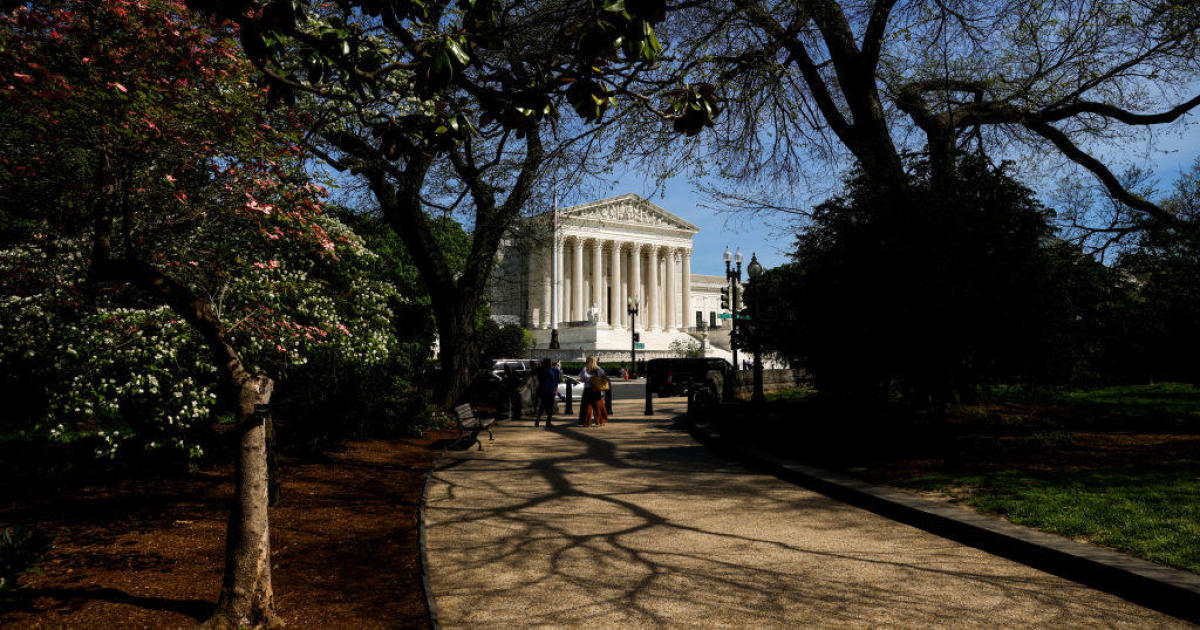Supreme Court under pressure to make live audio of arguments permanent
Washington — "Oyez, oyez, oyez." When Supreme Court marshal Pamela Talkin kicked off the court's session on May 4 with her cry, the high court projected an aura of business-as-usual despite the uncertainty that the coronavirus pandemic thrust on the rest of its term.
But one missing phrase from Talkin's usual cry — that those with business before the court are admonished to "draw near" — gave a subtle indication of the historic nature of the arguments. Instead of calling the court to order within the marble walls of One First Street across the street from the Capitol, the justices, lawyers and reporters covering the cases were fanned out across the country, and for the first time ever, the public was able to listen live.
The coronavirus pandemic forced the technology-resistant Supreme Court to make the jump into the 21st century, as it canceled arguments for its March and April sittings and rescheduled a select number to be heard telephonically in the first two weeks of May.
"Everyone who wanted to was able to listen in real time. That part worked out great," said Gabe Roth, executive director of Fix the Court, a group that advocates for a more transparent federal judiciary. "It's gotten very high marks in terms of access and frankly should be the new norm going forward for the court."
The foray into telephonic arguments with live audio went off with relatively few glitches, save for issues with the mute button and what sounded distinctly like a toilet flush. While there were some complaints about the format — justices asked questions one-by-one in order of seniority, with Chief Justice John Roberts maintaining strict time limits — the real-time audio received high marks across the board. The two weeks of remote sessions even saw participation from Justice Clarence Thomas, why typically does not ask questions during in-person arguments.
A poll conducted in mid-May by research firm PSB on behalf of Fix the Court found that 70% of U.S. adults surveyed believe the Supreme Court should continue providing live audio of oral arguments, and 83% supported the court's decision to provide real-time audio.
"If you want to not only understand what's going on at the court, but also see and hear an institution that by and large works, that is trying the best it can to get to find the solution that will get a majority of justices to stand behind, that's something that is often lost on folks if we don't have that visual or audio media coming out in real time," Roth said. "You're not going to have citizens pay attention to something that they can only see or hear several days later."
The Supreme Court typically posts audio of its oral arguments on Fridays, days after proceedings have concluded, though argument transcripts are released the day of. Only on rare occasions will the court publish audio on the same day it hears a case, with the most recent occurring in 2018 for arguments over President Trump's travel ban.
Numerous state supreme courts make live video of proceedings available, and some of the federal courts of appeals, such as the 9th U.S. Circuit, provide real-time audio or video. C-SPAN, meanwhile, has been bringing the halls of Congress into Americans' homes for more than 40 years.
Roth said that especially in an era of heightened polarization and partisan sniping, the Supreme Court can demonstrate to the public what collegiality among colleagues with differing views looks like.
"The fact that you have an institution that can disagree without being disagreeable is frankly refreshing, and if more Americans were able to hear that in real time, experience that in real time, I think it's something they would all internalize and say to themselves, 'Whatever is going on in the other two branches, at least we've got nine adults taking their jobs seriously and not trying to score political points,'" he said.
It's unclear whether the Supreme Court will make live audio a permanent fixture of proceedings — Roth pegs the odds at 50-50 — but the justices have expressed opposition to broadcasting oral arguments in the past.
During testimony on Capitol Hill last year, Justices Samuel Alito and Elena Kagan shot down the suggestion of allowing cameras in the courtroom, warning that courtroom behavior would suffer as a result.
"I think we would filter ourselves in ways that would be unfortunate," Kagan told lawmakers.
Alito, meanwhile, conceded that while he favored televising arguments before joining the Supreme Court in 2006, he now feels that doing so "would undermine their value to us as a step in the decision-making process."
But members of Congress disagree, and there is bipartisan support for the Supreme Court to adopt live streaming of its arguments on a permanent basis.
Congressman Mike Quigley, a Democrat from Illinois, said he hopes the court continues to stream audio once it returns to more normal proceedings.
"The success of the Supreme Court's live audio arguments underscores what I have long known to be true — live access to court arguments serves a critical public interest, increases transparency and are an invaluable educational tool," he said in a statement to CBS News. "The ease of the court's transition to live streaming also emphasizes just how far behind they have lagged in this area in the past."
Quigley, along with House Judiciary Committee Chairman Jerry Nadler of New York and Congressman Hank Johnson of Georgia, all Democrats, introduced legislation in March that would create live streaming and audio archive requirements for the Supreme Court and appellate courts
The editorial boards of some of the country's largest newspapers have also joined the chorus of calls for live audio to be made permanent.
"Live Supreme Court audio streaming did not undermine the caliber of the discussion in the exceptional instances in which it was allowed in the past, and it hasn't degraded the court during the past month," the Washington Post editorial board wrote Saturday.
Similarly, the Chicago Tribune's editorial board wrote Tuesday that the work of the Supreme Court "is a vital part of our system of government, and every American should have the opportunity to see how they do it."



